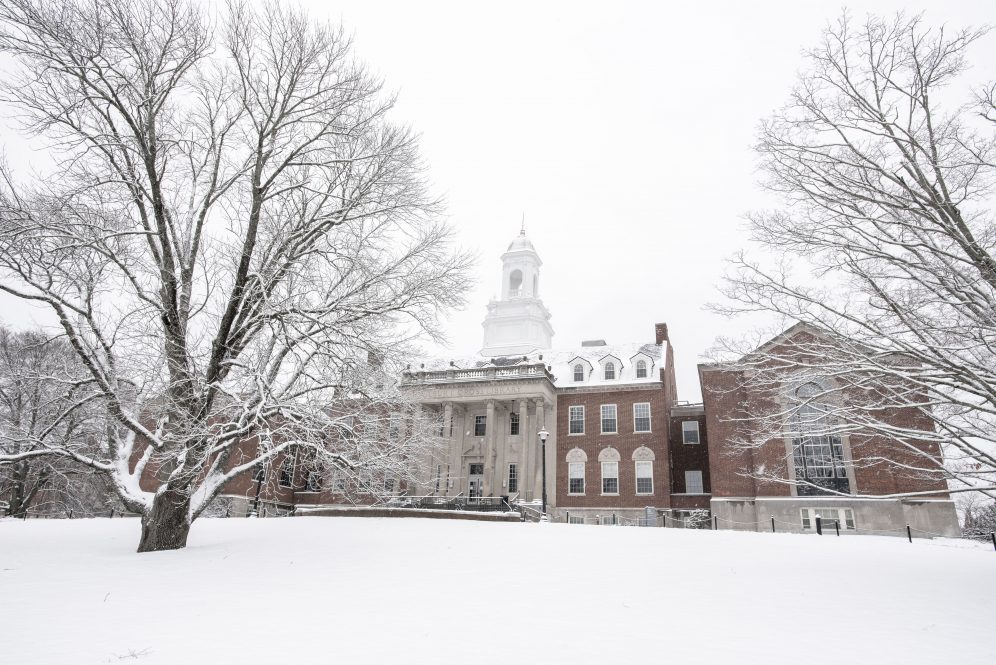UConn’s comprehensive COVID testing for off-campus students with in-person classes or similar obligations helped identify, and avoid introducing, 75 positive cases into the student body, new re-entry test results show.
Those positives are in addition to the 76 cases that UConn caught in re-entry testing of residential students, who had to quarantine and recover before they were authorized to move into their on-campus residence halls last month.
Overall, the figures show, UConn’s re-entry testing strategies halted more than 150 positive cases – which often are asymptomatic in college-age students – from circulating and spreading on its campuses, each of which had at least one positive result among its off-campus students who have on-campus commitments such as classes, work, or research.
“UConn remains vigilant in its effort to extensively test and quickly identity the presence of COVID-19 in our community,” says Eleanor JB Daugherty, UConn’s Dean of Students and Associate Vice President for Student Affairs.
“These efforts allows us to preserve in-person instruction, a residential program, and a healthy community throughout our campuses. As always, we thank our students, faculty, and staff for their care and concern for one another,” she says.
The off-campus students with on-campus obligations were required to test negative before they could come on campus for in-person activities, which started this week. UConn provided them with free access to the tests, as will continue to be the case throughout spring semester.
Every residential UConn student will be tested at least once each week this semester. Off-campus Storrs and Stamford students with an in-person obligation will be tested weekly in their entirety throughout February. Off-campus Storrs students will also be able to participate in the pooled saliva testing administered to on-campus students.
UConn received and logged more than 4,200 re-entry tests from off-campus students with an in-person obligation. Of those, the vast majority – about 3,400 – are Storrs-based students. Of those at Storrs, about 1.62 percent, or 55 students, had positive results.
At the other campuses, the results were: 10 positives out of 372 tests at UConn Hartford, or 2.7 percent; 4 out of 192 tests at Avery Point, or 2.1 percent; 4 out of 139 at Waterbury, or 2.9 percent; and 2 out of 109 at Stamford, or 1.8 percent.
Residential students moving into Storrs and Stamford student housing had to test at home and, even if they were negative then, they were tested again when they arrived over the weekend of Jan. 16 to 17.
Those who tested positive at home had to recover off campus before receiving their keys; those who tested positive upon arrival were quarantined on campus for medical care and allowed to move into their regular campus housing assignments once they had recovered and tested negative.
UConn’s combination of individual and pooled tests, along with analyses to detect the presence of the virus in campus wastewater, are part of a comprehensive Spring Reopen Plan that emphasizes testing frequently, encouraging healthy and safe behaviors, and using the expertise of the University’s scientific and healthcare community.
UConn administered or tracked more than 42,000 student COVID tests in fall semester; in spring, UConn Student Health and Wellness (SHaW) expects that number to well exceed 75,000.
Unlike some other campuses in larger communities, UConn collects and treats its own wastewater, which provides a perfect testing opportunity, since the presence of the virus in feces can give a seven-day head start to anticipate when a spike might occur.
Researchers collect and test wastewater from pumps around the Storrs campus, including the Wastewater Treatment Plant along with select lift stations and manholes. When a positive result is found, they narrow down to residence hall complexes and other areas on campus where the wastewater originated.
Then, large numbers of students in those halls participate in either individual testing or pooled testing in which they provided saliva samples in tubes, and each batch is tested – an approach far more speedy and cost-effective than widespread individual testing.
When a pooled sample batch tests negative, health officials can move on to the next. If it tests positive, every individual student in the pool is administered a diagnostic COVID-19 PCR test.
In addition to being efficient, it also offers a huge cost savings: Pooled tests cost the University about $4 per student sample, while individual clinical tests can range from about $50 to $140 each. The technology also helps to pinpoint students who are carrying the virus but either are asymptomatic, or have very mild symptoms they might mistake for something else.
In addition to expanding its current testing practices in spring semester to include more collection sites, UConn will also soon start tracking the presence of the flu virus in its wastewater.
The University also continues to offer updates on the testing on a public dashboard with a newly added red/yellow/green system of alert levels for residential students so parents, community members, and others can check campus health indicators.
Other critical pieces of the campus testing strategy provided by the SHaW clinical staff include checking symptomatic students with rapid PCR testing, conducting timely and comprehensive contact tracing, enacting quarantine and isolation strategies, and enforcing positive behaviors such as wearing masks, frequent hand-washing, and physical distancing.



